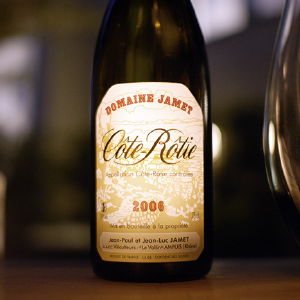 So, it’s straight back to the most northerly appellation of a famous strip of prime French real estate today – this time Côte Rôtie in the Northern Rhone. The ‘roasted slope’ from which the appellation takes its name produces the most perfumed and subtly voluptuous wine of the region from vineyards so steep that farming them is an occupational hazard; if you don’t fall and break your leg the day-long exposure to the sun’s most intense rays spells trouble for those that fail to pack their Ambre Solaire.
So, it’s straight back to the most northerly appellation of a famous strip of prime French real estate today – this time Côte Rôtie in the Northern Rhone. The ‘roasted slope’ from which the appellation takes its name produces the most perfumed and subtly voluptuous wine of the region from vineyards so steep that farming them is an occupational hazard; if you don’t fall and break your leg the day-long exposure to the sun’s most intense rays spells trouble for those that fail to pack their Ambre Solaire.
There’s more than a hint of the aromatic allure of red Burgundy in Côte Rôtie, something I’d always attributed to the fact that French wine law allows up to 10% of the white grape Viognier alongside the predominant Syrah in the blend, giving it fragrance and softening the tannins. Apparently not, though, as it turns out blending of white grapes here is largely ancient history and few producers deviate from 100 percent Syrah. It’s surprising, given the robust and often unyielding character the grape can take on in other parts of the Rhone and under its supermarket-friendly name, Shiraz, across parts of the New World.
This mid-weight 2006 is already drinking well and showing the faintly schizophrenic character that makes Côte Rôtie such an unforgettable wine experience. Purple moves to a light brick rim in the glass with raspberry fruit driving the aromas and anchored by an undertow of typical syrah notes: leather, coffee and spice. It is velvet in the mouth; the tannins beautifully integrated, conveying the wine’s darker characteristics – damson and prune – with good persistency. It’s not exactly an iron fist wrapped in a velvet glove, more a spiced meatball sitting in a gloriously fresh pomodoro sauce. So, what’s our musical pairing?
 In 1970, The Velvet Underground recorded their final album, Loaded, whose name referred to Atlantic Records’ insistence that the band deliver an album “loaded with hits”. It’s a record that’s become a teenage right of passage, largely due to the enduring appeal of the songs ‘Sweet Jane’ and ‘Rock & Roll’, however it’s questionable that many of its admirers could name every track.
In 1970, The Velvet Underground recorded their final album, Loaded, whose name referred to Atlantic Records’ insistence that the band deliver an album “loaded with hits”. It’s a record that’s become a teenage right of passage, largely due to the enduring appeal of the songs ‘Sweet Jane’ and ‘Rock & Roll’, however it’s questionable that many of its admirers could name every track.
That’s because it’s not the first Velvets record you’d wheel out as evidence of the true artistic vision of the band. It’s an anomaly in which the notoriously abrasive, avant garde inclinations of Warhol-era VU is subdued in favour of irresistible pop melody and the harmonic joie de vive of genius having a lot of fun with the FM template. It’s the absence of Welshman and force of all things willfully ‘difficult’ in the world of VU, John Cale, that partly explains the shift in styles that began with the previous record and finds its logical conclusion here. Cale was a classically trained song-arranger (empirically the first artrock hero to emerge from London’s Goldsmith’s college in line that would include Blur) whose experimental inclinations led him to collaborte early on with key avant guarde figures like La Monte Young.
Lou Reed, on the other hand, started out as an in-house songwriter for Pickwick Records where he composed novelty hits, including a dance track called ‘The Ostrich’ – a far cry from the famously morose solo material he released throughout the 90s. But it’s Lou Reed’s inability to do sweetness and light that makes Loaded. Beneath the surface lies punk attitude, beatific world-weariness (‘Oh! Sweet Nuthin’, in particular) and every suggestion of the darker currents that drove this extraordinary band.
Can you see where I’m going with this yet?
Uncharacteristically approachable, harbouring darker, savoury depths beneath a moreish surface, if you can’t stand a one-dimensional wine (or album for that matter), Côte Rôtie and Loaded may be just the split personality you’re looking for.